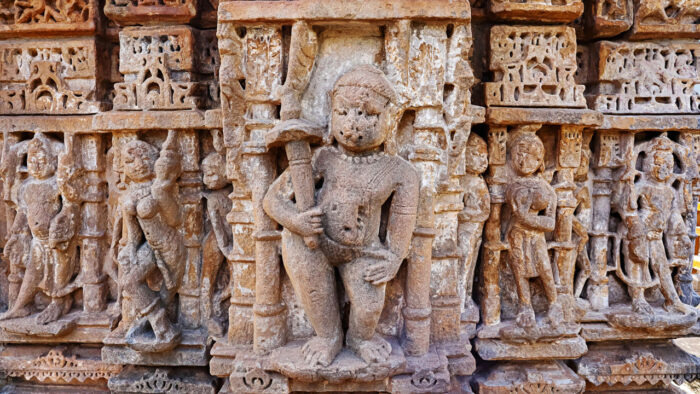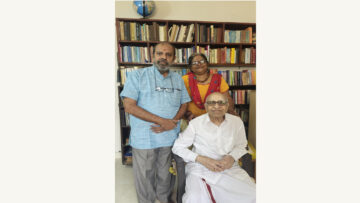Abstract
The article provides an overview of Hindutva as a civilization voice rather than a political entity. The literature provides its perspective on global problems. Towards the end, it looks at the threats to Hindutva which are basically residues as mentioned by Sita Ram Goel Ji in his book, ‘Hinduism under Siege’, and the article ends with an optimistic conclusion.
Hindutva: Flourishing beyond Politics
As Vinayak Damodar Savarkar’s in his ‘Essentials of Hindutva, says, “a Hindu is someone who considers India to be his motherland (matrbhoomi), the land of their ancestors (pitrbhoomi), and their holy land (punyabhoomi)”. This definition extends beyond religion, positioning Hindutva as an ethnic, cultural, and political identity rather than merely a religious one. It is beyond the geographical identity confined to a life along the River Indus. Even in that sense, the history stretches to the Saraswati Civilization, much beyond the conventional five thousand years of the Indus Valley Civilization. Hindutva is far from the confined contemporary political definitions of being a socialist or a secular state. It is not something shown as a meek community with unusual tolerance or a group of humans with meaningless inclusiveness, inviting migrants and then disturbing its own demography. Looking deep into its reservoir of knowledge, one realizes that it is a scientific, logical and sustainable way of living or simply put, a flourishing civilization.
Hindutva: Not just a religion, or a nation state but a basis for the best civilizational state
Beyond theology that can be left stuck between superstition, theism, atheism and such doubts, Hindutva carries within a seed that can and have in fact resulted into the best possible civilization on the planet. This is a beautiful way of existence where on surface level, one sees temples being run by faith but actually they run economies of cities like Kashi and Mathura. Even the early maps of the subcontinent were formed through its circuits of various pilgrimages, char dham being one of them. It has been a way of life where sex does not fall in the category of taboo, later becoming an obsession like it happens in the west. Kamashastra and Khajuraho are evident that we not only normalized physical intimacy, but also studied it with all its emotional aspects. The rituals performed at birth, marriage and at last death are not just ceremonial, but they are pillars shaping the structures of lives, balancing charity, passion, compassion and much needed detachment from the world.
Hindutva carries within the possibility of a culture where females celebrate their beauty with complete dignity and pride, not being caged in veils and capes, and still being objectified and exploited. The education system as per Indian Civilization is not about professing but discovering, wherein, the learner has as much right to think, inquire, and discover as the instructor, who is a guide, not a master or professor. The discussion between Shankaracharya and Mandan Mishra is often cited as an iconic example of this tradition called Upanishad. In short, it is a civilizational worldview rather than a political ideology.
Hence, while the rest of the world tends to have nation states within a uniform religion or set of beliefs, Hindutva carries a possibility of a civilizational state that can even accommodate the whole world as its part, accepting every individual, with its diverse set of beliefs as its part.
The consistency of Hindutva can be seen in the fact that it has sustained one-sixth of humanity for over a millennia and that too keeping it the world’s number one GDP for across fifteen centuries.
Global challenges and civilizational perspective of Hindutva
Consumerism
As they say, people used to use things and love people; the western world today has reversed roles. People today define their life not by their network but by their net worth, the more expensive phone you buy, the more confident you become. On the contrary, teachings in Hindutva refer to the ideas of Aparigraha (non-hoarding) and Santosh (contentment).
The lessons from Hindutva would lead to avoiding problems rather than creating a whole market for its solutions. For example a beautiful blend of yoga and ayurveda, results in a healthy lifestyle management system. If one follows it diligently, he or she is not likely to spend much money in the fast growing market of cosmetics, multivitamins, gymnastics and other common yet abnormal solutions.
Violence
As Robert Frost in his Mending Wall, says, ‘Good fences make good neighbours,’ Be it war between Russia and Ukraine or foolish advances of Pakistan towards India, one thing is common, one of the two nations has downplayed its safety and didn’t ensure powerful walls. Shri Tulsidas Ji in Ram Charit Manas says, ‘Bhay Bin Hot na preet’. Hindutva is not about being proud and beaten like the honourable father of nation is shown saying in the ‘Lage Raho Munna bhai’ movie, but it is about being self sufficient to protect oneself and then taking care of the weak.
Feminism and Wokeism
Hindutva has clear compartment of sexes i.e. male and female that applies to genders, some cases of transgender being respected can be seen like Shrikhandini but the concept of fluid gender and never ending lists of LGBTQ++ growing fast in the academia shows how Indian youth is forgetting not just their cultural roots but the natural call of their bodies, being driven by self guilt of belonging to heterosexual majority. While the so – called fake feminists use obscenity to express empowerment, Hindutva follows a tradition where women are considered even more powerful and important than men, not just equal to them. From the rishikas in Gurukuls to Rajmata Devi Ahilaya Bai Holkar, Hindutva has shown the world how feminine powers flourish and rule as beautifully as masculine. Unfortunately, post independent India carries poems like, ‘mummy ki roti gol gol, papa ka paisa gol gol’ showing children a mother gently framed around household chores.
Casteism
As per Swami Vivekananda’s reinterpretation, Varna in India has been a socio-professional, not hereditary system. Someone from the US tried to have casteist comments on India saying Brahmins hold more wealth in India, this shows that anti India powers within and outside India are more conscious of this stigma than us, but Hindutva did not have such a rigid caste system as displayed by the modern messiahs of dalits. Rather it was a flexible system of pursuing one’s profession.
Education
Even after more than seven and a half decades of independence, our education system seems to be in the hangover of an education system that Thomas Babington Macaulay envisioned, creating a class of individuals who were Indian in blood and colour but English in taste, opinions, morals, and intellect. Yes the names, curriculum, and somehow books have evolved but the motive of education seems the same – to produce clerks not learned men.
The education system as per Hindutva is holistic and practical. While the gurukul tradition let students explore the knowledge by themselves, resources didn’t matter but what mattered were curiosity and the way of learning it. The way of teaching was authoritative, not authoritarian – which means the teacher just facilitated, not controlled the learners. The mystics and saints in Hindutva are not ignorant but absorbed in seeking knowledge; Swami Vivekananda is one such example.
Fraternity
Recent G 20, had a motto, ‘vasudhev kutumbkam’ which comes from, ‘अयं निजः परो वेति गणना लघुचेतसाम्। उदारचरितानां तु वसुधैव कुटुम्बकम्॥’ (ayaṁ nijaḥ paro vetti gaṇanā laghu-cetasām, udāra-caritānāṁ tu vasudhaiva kuṭumbakam), told to great warrior Arjuna by Shri Krishna in Shrimad Bhagavadgita. The motto by our democratically elected government highlights that our nation Bharata and its realm still believes in treating the world as a family, beyond the narrow boundaries of caste, creed, nation or religion.
Mental health
As Dale Carnegie says, ‘Young men who don’t know how to handle stress die early’. Cardiac arrests and suicides at young age seem to be the result of over emphasizing one’s actions, ‘American Dream’ and ‘Free Will’ seem to dominate, when one believes everything is being done with one’s efforts, one goes away from ‘nishkama karma yog’ as defined in the Gita. A sense of surrender seems to be absent and results in ultimate disappointment and sometimes an untimely end to life.
Sustainability
Hindus have always known that their bodies are made up of ‘panch mahabhutas’. Ironically, the world today seems to be a cooperative society which has a challenge of gathering some funds to solve a petty problem like installing a new pipeline, initiatives like Paris Climate, Cop 21 and earth summits seem to be mere goodwill gestures and our fear of extinction while Hindutva carries this sense of sustainability as its core ideas. Coordinating with nature and not exploiting it has been a part of our civilization. Our cremation techniques since Vedic times is an example, where the mortal remains that contain phosphorus are erased in rivers and act as fertilizers in the farms on the banks of Sapta Sindhu. Modern day farming is now moving towards organic ways, while we have always used this as an indispensable part. Similarly natural extracts like neem, babool, multani mitti, turmeric and other edible items can act as cosmetics.
Is Hindutva eclipsed?
Yes, even after being such a supreme belief system, Hindutava has threats from some residues still extant on our soil that are the aftereffects of the dark British and Islamic rule. Unfortunately still gloried in the textbook chapters with headings like The Great Mughal Era, The Delhi Sultanate and Akbar the Great. As Sitaram Goel Ji mentions in his book, ‘Hinduism under Siege’, such residues are Macaulayism, Islamism, Christianism, and Communism.
Let’s look briefly at them.
Macaulayism
The impact of Macaulayism can be easily seen as a hangover of colonialism in India, the tendency of questioning almost every Hindu ritual, like ‘Jal Abhishek on Mahadev’, bursting crackers during Diwali or colours during Holi, vedic marriage rituals, while readily accepting the same concept once they are validated by the Western canons. It’s an irony that Ekadashi seems a myth while intermediate fasting seems logical.
Islamism and Christianism
Being aware of these residues does not mean hating those belonging to the Abrahamic fold, but such awareness is of utmost importance, especially in acknowledging the sudden attacks that we have witnessed, such as the one on Kanhaiya Lal in Udaipur. An urban youngster with a mind intoxicated with sweet drugs of liberalism and secularism would not accept that Hindus, even in the 21st century, still encounter the organized efforts of the conversion mafia working rigorously to draw people away from their traditions. Such conversions in villages, tribes and cities are rampant, being funded from within India and abroad.
Communism
It is the intellectual force that propagates vicious theories like Aryan Invasion Theory, declaring Indian History as limited to the Mughal Era. These evil forces still try to glorify the bloody colonial period as a development harnessing force.
Conclusion
Hindutva, as a civilizational living pattern, stands far beyond contemporary political definitions. Its complete and unbiased study, and its sincere application, can truly ‘MAKE INDIA GREAT AGAIN.’
References
https://www.indica.today/reviews/hindu-society-under-siege-by-sita-ram-goel
Feature Image Credit: istockphoto.com
Disclaimer: The opinions expressed in this article belong to the author. Indic Today is neither responsible nor liable for the accuracy, completeness, suitability, or validity of any information in the article.









